PCD101FC Tourism and Destination Management Plan Analysis Report
VerifiedAdded on 2022/09/14
|12
|1986
|12
Report
AI Summary
This report provides an in-depth analysis of the destination management plan for New South Wales, focusing on the roles and structure of destination management organizations and their relationships with various tourism stakeholders. It begins with an overview of the New South Wales visitor economy, highlighting its contribution to the state's economy and the government's initiatives to boost tourism. The report then identifies key stakeholders, including government bodies, industry groups, and local tourism organizations, and examines the products and objectives of the region. It also delves into the roles and structure of destination management organizations, emphasizing the collaborative approach in New South Wales. Furthermore, the report analyzes emerging trends and changes in the global tourism landscape, such as the impact of school holiday cycles and shifts in visitor demographics. Finally, it proposes potential strategies for the next destination management plan, including advocating for the destination, facilitating infrastructure and experience development, and maximizing the benefits of funding programs. The conclusion emphasizes the importance of destination management plans in shaping tourism policies and achieving common goals within the region.
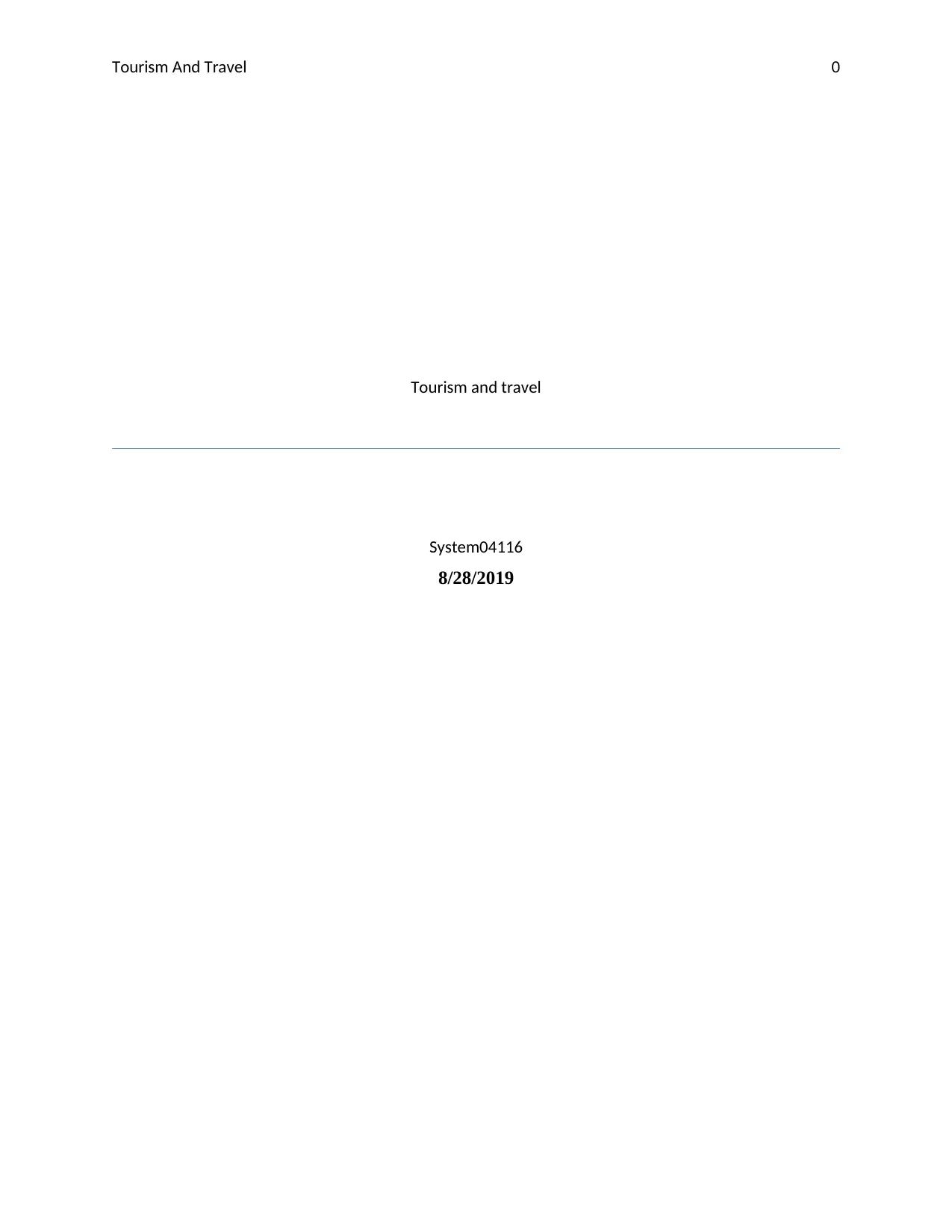
Tourism And Travel 0
Tourism and travel
System04116
8/28/2019
Tourism and travel
System04116
8/28/2019
Paraphrase This Document
Need a fresh take? Get an instant paraphrase of this document with our AI Paraphraser
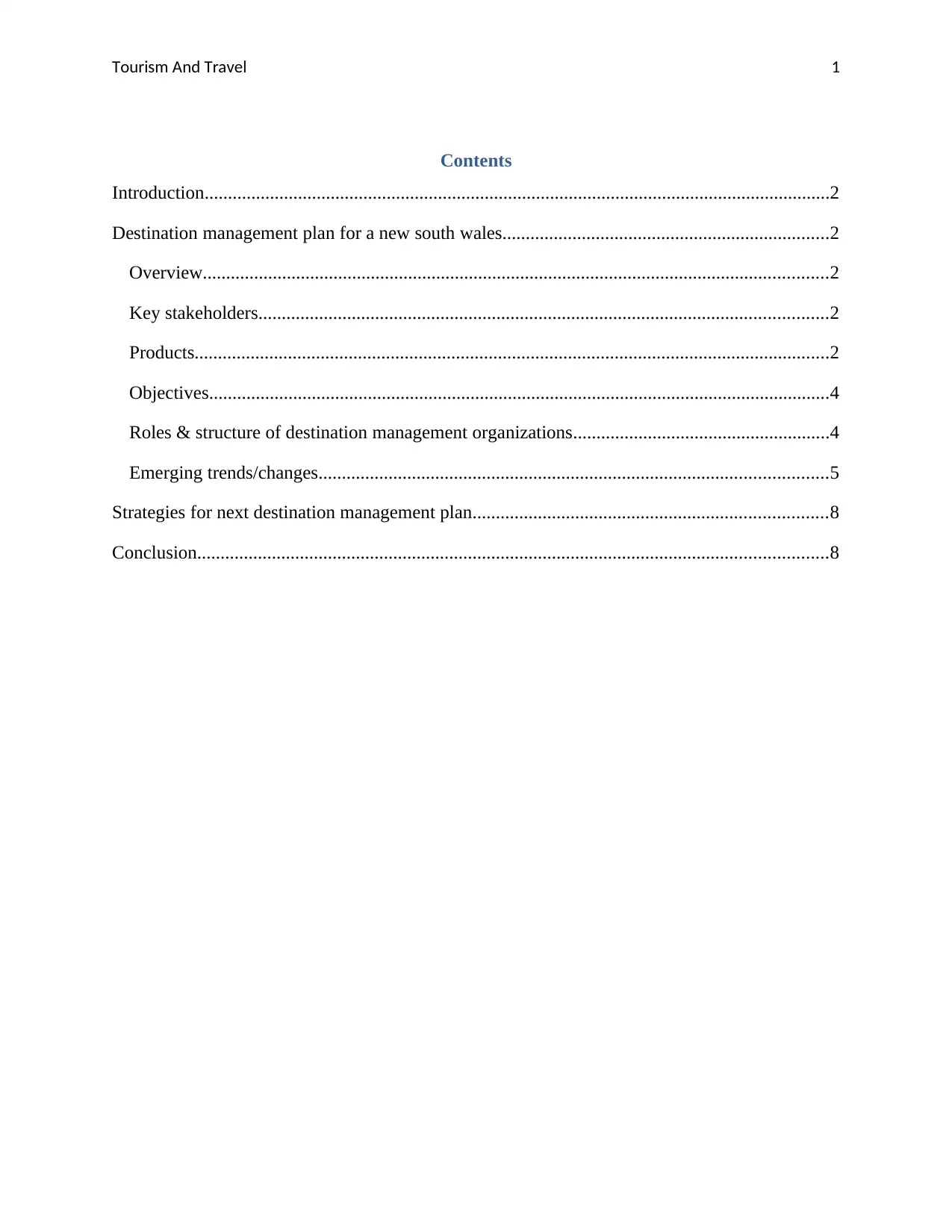
Tourism And Travel 1
Contents
Introduction......................................................................................................................................2
Destination management plan for a new south wales......................................................................2
Overview......................................................................................................................................2
Key stakeholders..........................................................................................................................2
Products........................................................................................................................................2
Objectives.....................................................................................................................................4
Roles & structure of destination management organizations.......................................................4
Emerging trends/changes.............................................................................................................5
Strategies for next destination management plan............................................................................8
Conclusion.......................................................................................................................................8
Contents
Introduction......................................................................................................................................2
Destination management plan for a new south wales......................................................................2
Overview......................................................................................................................................2
Key stakeholders..........................................................................................................................2
Products........................................................................................................................................2
Objectives.....................................................................................................................................4
Roles & structure of destination management organizations.......................................................4
Emerging trends/changes.............................................................................................................5
Strategies for next destination management plan............................................................................8
Conclusion.......................................................................................................................................8
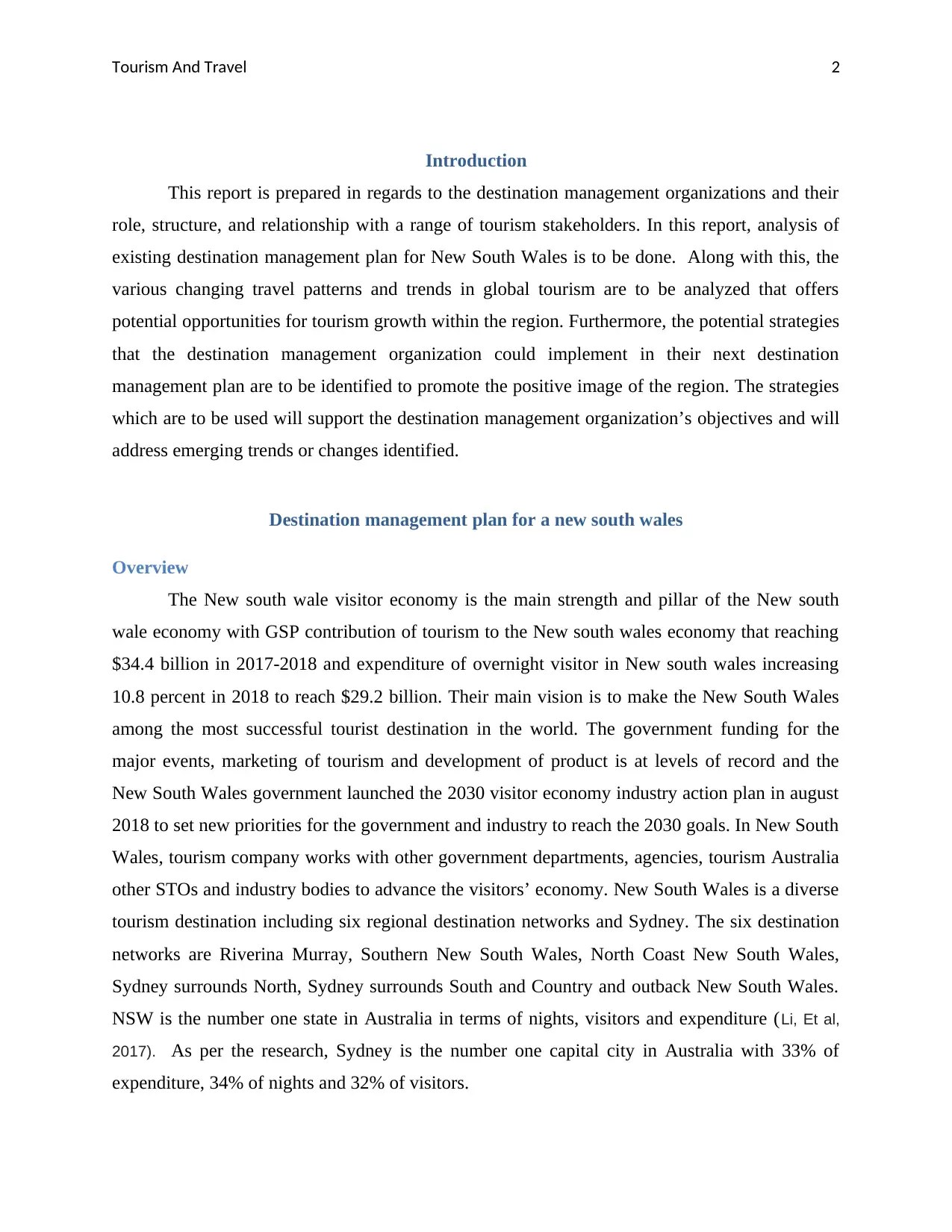
Tourism And Travel 2
Introduction
This report is prepared in regards to the destination management organizations and their
role, structure, and relationship with a range of tourism stakeholders. In this report, analysis of
existing destination management plan for New South Wales is to be done. Along with this, the
various changing travel patterns and trends in global tourism are to be analyzed that offers
potential opportunities for tourism growth within the region. Furthermore, the potential strategies
that the destination management organization could implement in their next destination
management plan are to be identified to promote the positive image of the region. The strategies
which are to be used will support the destination management organization’s objectives and will
address emerging trends or changes identified.
Destination management plan for a new south wales
Overview
The New south wale visitor economy is the main strength and pillar of the New south
wale economy with GSP contribution of tourism to the New south wales economy that reaching
$34.4 billion in 2017-2018 and expenditure of overnight visitor in New south wales increasing
10.8 percent in 2018 to reach $29.2 billion. Their main vision is to make the New South Wales
among the most successful tourist destination in the world. The government funding for the
major events, marketing of tourism and development of product is at levels of record and the
New South Wales government launched the 2030 visitor economy industry action plan in august
2018 to set new priorities for the government and industry to reach the 2030 goals. In New South
Wales, tourism company works with other government departments, agencies, tourism Australia
other STOs and industry bodies to advance the visitors’ economy. New South Wales is a diverse
tourism destination including six regional destination networks and Sydney. The six destination
networks are Riverina Murray, Southern New South Wales, North Coast New South Wales,
Sydney surrounds North, Sydney surrounds South and Country and outback New South Wales.
NSW is the number one state in Australia in terms of nights, visitors and expenditure (Li, Et al,
2017). As per the research, Sydney is the number one capital city in Australia with 33% of
expenditure, 34% of nights and 32% of visitors.
Introduction
This report is prepared in regards to the destination management organizations and their
role, structure, and relationship with a range of tourism stakeholders. In this report, analysis of
existing destination management plan for New South Wales is to be done. Along with this, the
various changing travel patterns and trends in global tourism are to be analyzed that offers
potential opportunities for tourism growth within the region. Furthermore, the potential strategies
that the destination management organization could implement in their next destination
management plan are to be identified to promote the positive image of the region. The strategies
which are to be used will support the destination management organization’s objectives and will
address emerging trends or changes identified.
Destination management plan for a new south wales
Overview
The New south wale visitor economy is the main strength and pillar of the New south
wale economy with GSP contribution of tourism to the New south wales economy that reaching
$34.4 billion in 2017-2018 and expenditure of overnight visitor in New south wales increasing
10.8 percent in 2018 to reach $29.2 billion. Their main vision is to make the New South Wales
among the most successful tourist destination in the world. The government funding for the
major events, marketing of tourism and development of product is at levels of record and the
New South Wales government launched the 2030 visitor economy industry action plan in august
2018 to set new priorities for the government and industry to reach the 2030 goals. In New South
Wales, tourism company works with other government departments, agencies, tourism Australia
other STOs and industry bodies to advance the visitors’ economy. New South Wales is a diverse
tourism destination including six regional destination networks and Sydney. The six destination
networks are Riverina Murray, Southern New South Wales, North Coast New South Wales,
Sydney surrounds North, Sydney surrounds South and Country and outback New South Wales.
NSW is the number one state in Australia in terms of nights, visitors and expenditure (Li, Et al,
2017). As per the research, Sydney is the number one capital city in Australia with 33% of
expenditure, 34% of nights and 32% of visitors.
⊘ This is a preview!⊘
Do you want full access?
Subscribe today to unlock all pages.

Trusted by 1+ million students worldwide
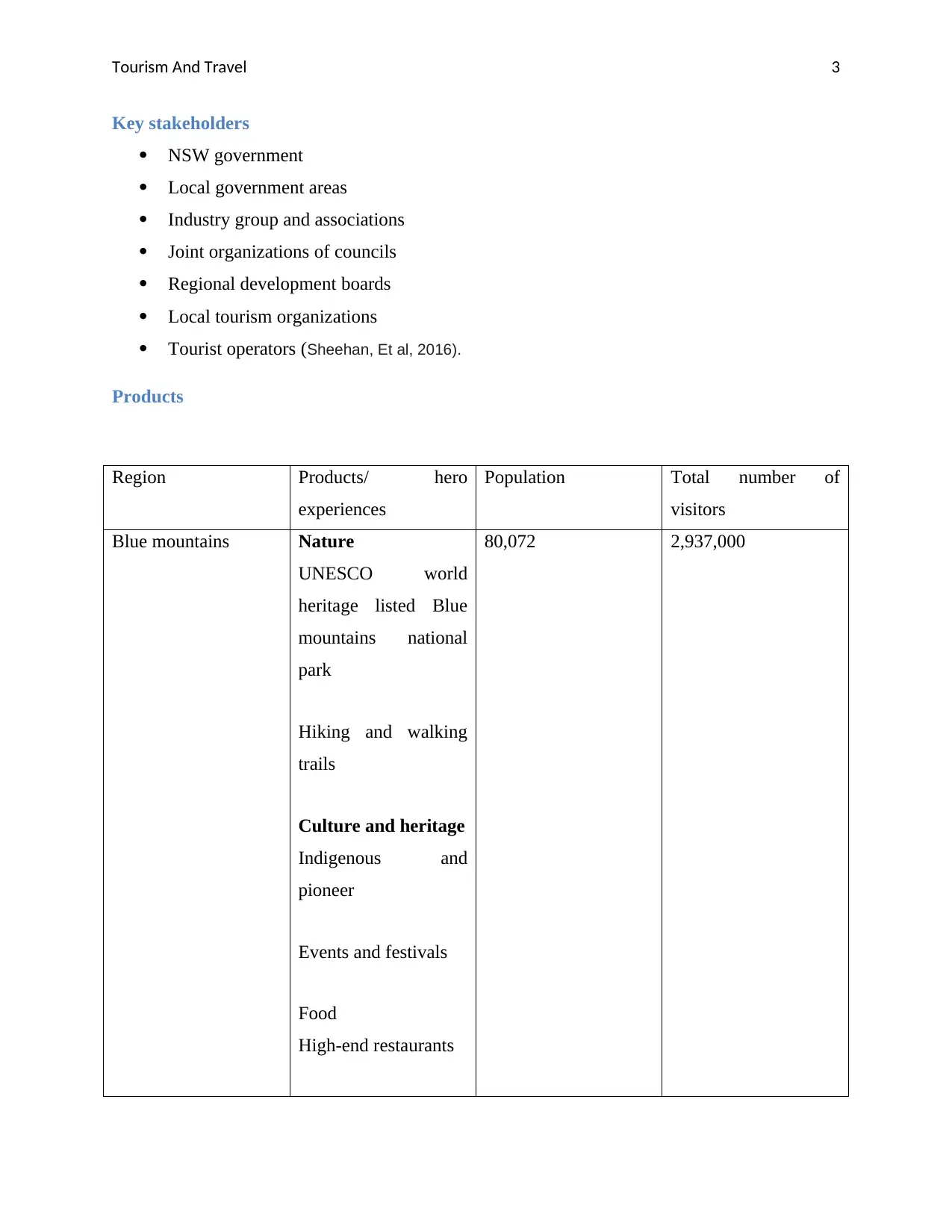
Tourism And Travel 3
Key stakeholders
NSW government
Local government areas
Industry group and associations
Joint organizations of councils
Regional development boards
Local tourism organizations
Tourist operators (Sheehan, Et al, 2016).
Products
Region Products/ hero
experiences
Population Total number of
visitors
Blue mountains Nature
UNESCO world
heritage listed Blue
mountains national
park
Hiking and walking
trails
Culture and heritage
Indigenous and
pioneer
Events and festivals
Food
High-end restaurants
80,072 2,937,000
Key stakeholders
NSW government
Local government areas
Industry group and associations
Joint organizations of councils
Regional development boards
Local tourism organizations
Tourist operators (Sheehan, Et al, 2016).
Products
Region Products/ hero
experiences
Population Total number of
visitors
Blue mountains Nature
UNESCO world
heritage listed Blue
mountains national
park
Hiking and walking
trails
Culture and heritage
Indigenous and
pioneer
Events and festivals
Food
High-end restaurants
80,072 2,937,000
Paraphrase This Document
Need a fresh take? Get an instant paraphrase of this document with our AI Paraphraser
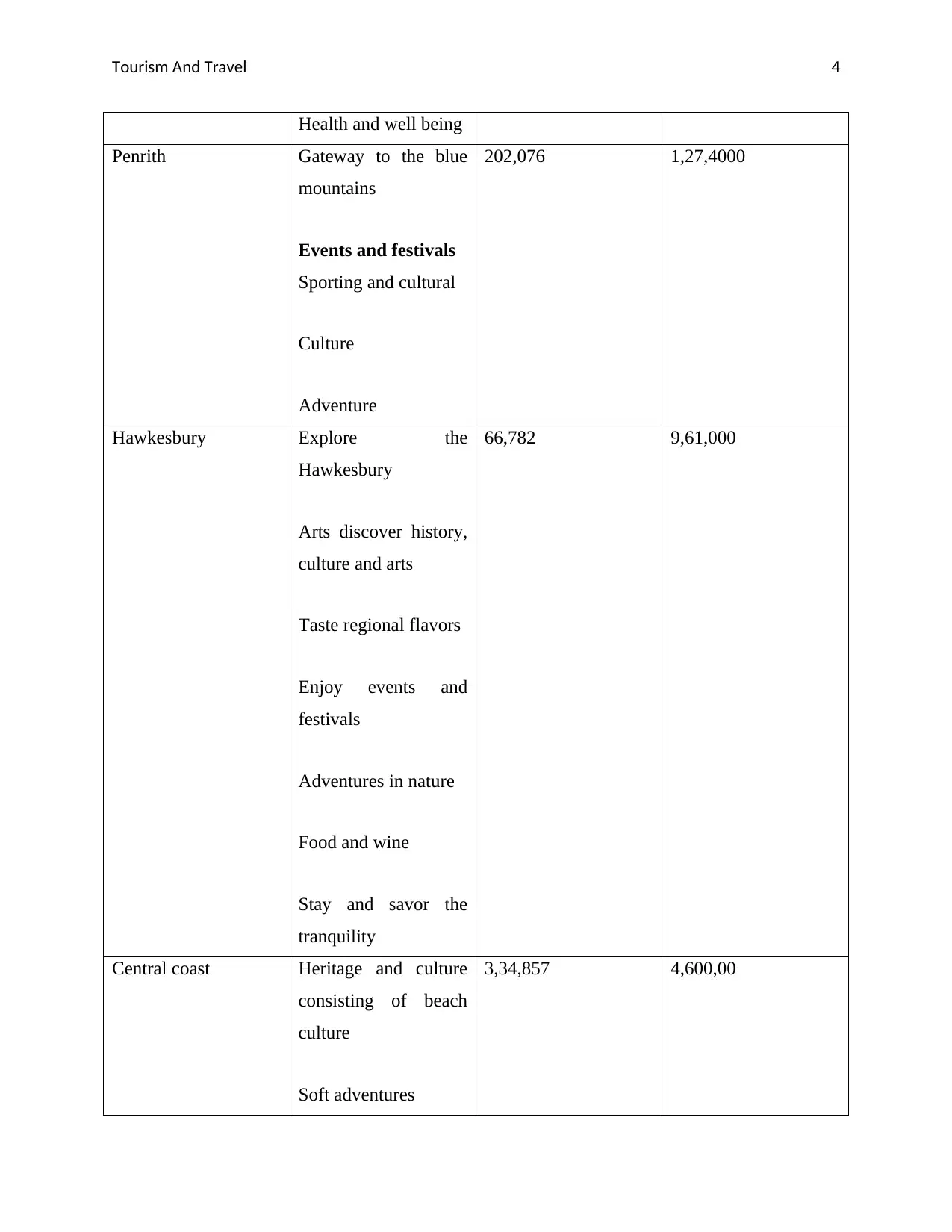
Tourism And Travel 4
Health and well being
Penrith Gateway to the blue
mountains
Events and festivals
Sporting and cultural
Culture
Adventure
202,076 1,27,4000
Hawkesbury Explore the
Hawkesbury
Arts discover history,
culture and arts
Taste regional flavors
Enjoy events and
festivals
Adventures in nature
Food and wine
Stay and savor the
tranquility
66,782 9,61,000
Central coast Heritage and culture
consisting of beach
culture
Soft adventures
3,34,857 4,600,00
Health and well being
Penrith Gateway to the blue
mountains
Events and festivals
Sporting and cultural
Culture
Adventure
202,076 1,27,4000
Hawkesbury Explore the
Hawkesbury
Arts discover history,
culture and arts
Taste regional flavors
Enjoy events and
festivals
Adventures in nature
Food and wine
Stay and savor the
tranquility
66,782 9,61,000
Central coast Heritage and culture
consisting of beach
culture
Soft adventures
3,34,857 4,600,00
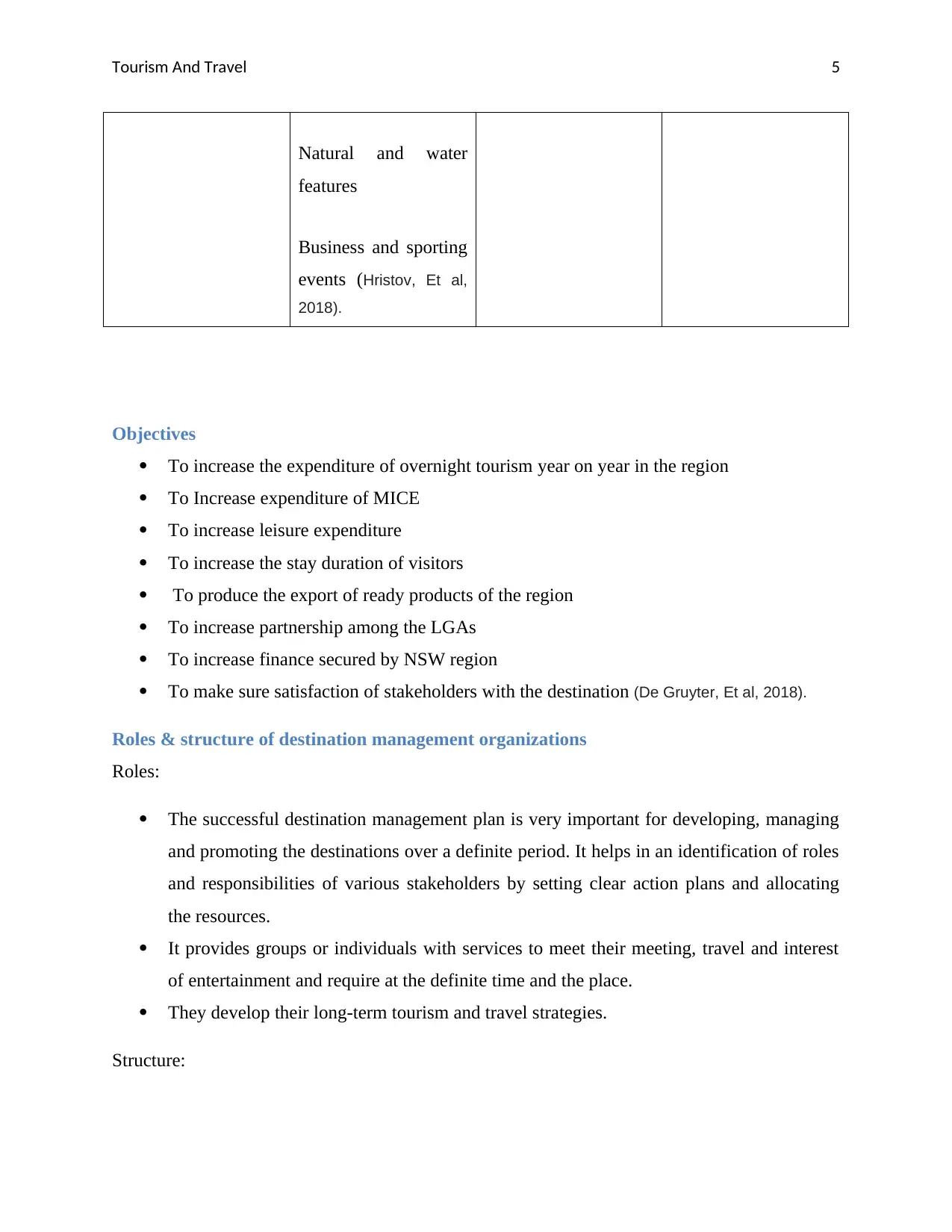
Tourism And Travel 5
Natural and water
features
Business and sporting
events (Hristov, Et al,
2018).
Objectives
To increase the expenditure of overnight tourism year on year in the region
To Increase expenditure of MICE
To increase leisure expenditure
To increase the stay duration of visitors
To produce the export of ready products of the region
To increase partnership among the LGAs
To increase finance secured by NSW region
To make sure satisfaction of stakeholders with the destination (De Gruyter, Et al, 2018).
Roles & structure of destination management organizations
Roles:
The successful destination management plan is very important for developing, managing
and promoting the destinations over a definite period. It helps in an identification of roles
and responsibilities of various stakeholders by setting clear action plans and allocating
the resources.
It provides groups or individuals with services to meet their meeting, travel and interest
of entertainment and require at the definite time and the place.
They develop their long-term tourism and travel strategies.
Structure:
Natural and water
features
Business and sporting
events (Hristov, Et al,
2018).
Objectives
To increase the expenditure of overnight tourism year on year in the region
To Increase expenditure of MICE
To increase leisure expenditure
To increase the stay duration of visitors
To produce the export of ready products of the region
To increase partnership among the LGAs
To increase finance secured by NSW region
To make sure satisfaction of stakeholders with the destination (De Gruyter, Et al, 2018).
Roles & structure of destination management organizations
Roles:
The successful destination management plan is very important for developing, managing
and promoting the destinations over a definite period. It helps in an identification of roles
and responsibilities of various stakeholders by setting clear action plans and allocating
the resources.
It provides groups or individuals with services to meet their meeting, travel and interest
of entertainment and require at the definite time and the place.
They develop their long-term tourism and travel strategies.
Structure:
⊘ This is a preview!⊘
Do you want full access?
Subscribe today to unlock all pages.

Trusted by 1+ million students worldwide
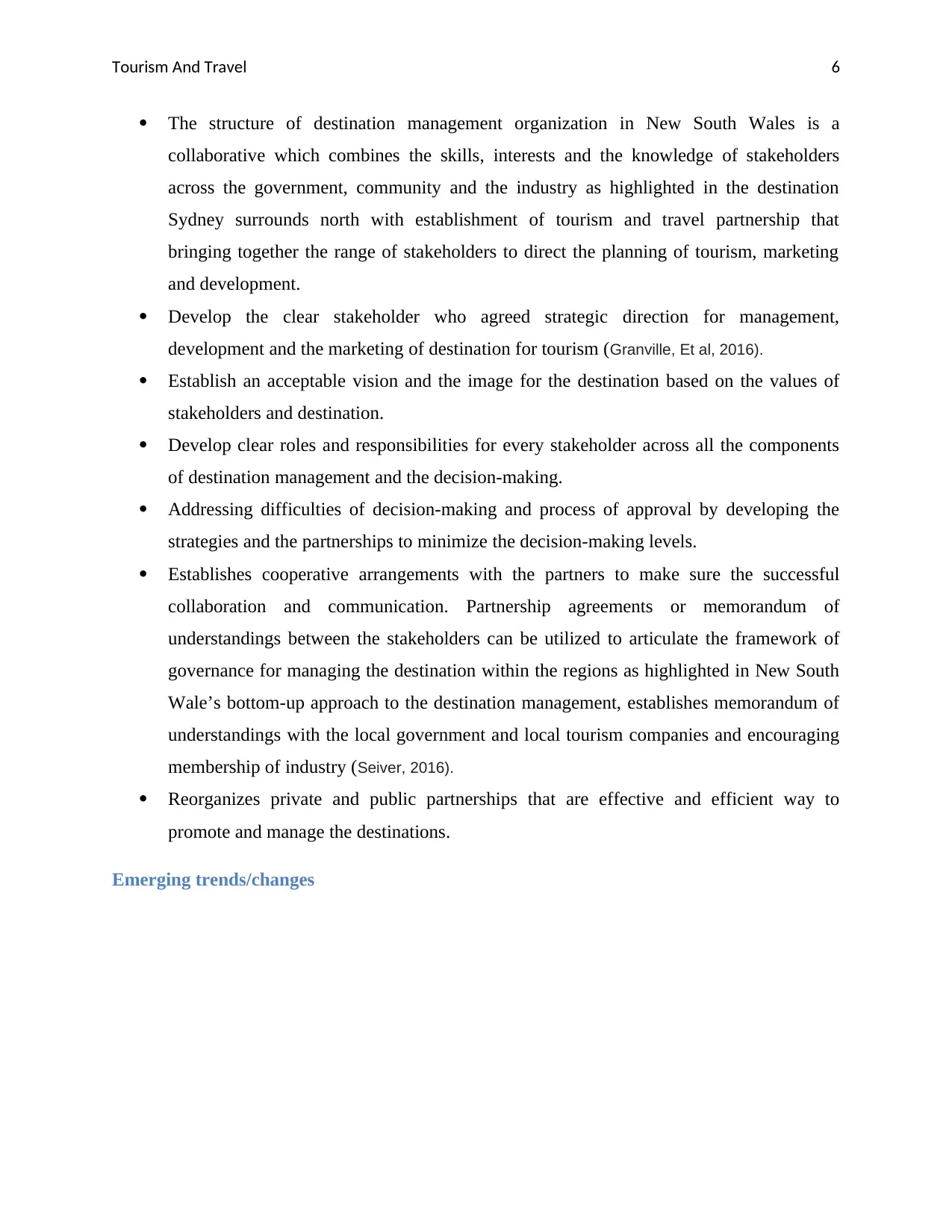
Tourism And Travel 6
The structure of destination management organization in New South Wales is a
collaborative which combines the skills, interests and the knowledge of stakeholders
across the government, community and the industry as highlighted in the destination
Sydney surrounds north with establishment of tourism and travel partnership that
bringing together the range of stakeholders to direct the planning of tourism, marketing
and development.
Develop the clear stakeholder who agreed strategic direction for management,
development and the marketing of destination for tourism (Granville, Et al, 2016).
Establish an acceptable vision and the image for the destination based on the values of
stakeholders and destination.
Develop clear roles and responsibilities for every stakeholder across all the components
of destination management and the decision-making.
Addressing difficulties of decision-making and process of approval by developing the
strategies and the partnerships to minimize the decision-making levels.
Establishes cooperative arrangements with the partners to make sure the successful
collaboration and communication. Partnership agreements or memorandum of
understandings between the stakeholders can be utilized to articulate the framework of
governance for managing the destination within the regions as highlighted in New South
Wale’s bottom-up approach to the destination management, establishes memorandum of
understandings with the local government and local tourism companies and encouraging
membership of industry (Seiver, 2016).
Reorganizes private and public partnerships that are effective and efficient way to
promote and manage the destinations.
Emerging trends/changes
The structure of destination management organization in New South Wales is a
collaborative which combines the skills, interests and the knowledge of stakeholders
across the government, community and the industry as highlighted in the destination
Sydney surrounds north with establishment of tourism and travel partnership that
bringing together the range of stakeholders to direct the planning of tourism, marketing
and development.
Develop the clear stakeholder who agreed strategic direction for management,
development and the marketing of destination for tourism (Granville, Et al, 2016).
Establish an acceptable vision and the image for the destination based on the values of
stakeholders and destination.
Develop clear roles and responsibilities for every stakeholder across all the components
of destination management and the decision-making.
Addressing difficulties of decision-making and process of approval by developing the
strategies and the partnerships to minimize the decision-making levels.
Establishes cooperative arrangements with the partners to make sure the successful
collaboration and communication. Partnership agreements or memorandum of
understandings between the stakeholders can be utilized to articulate the framework of
governance for managing the destination within the regions as highlighted in New South
Wale’s bottom-up approach to the destination management, establishes memorandum of
understandings with the local government and local tourism companies and encouraging
membership of industry (Seiver, 2016).
Reorganizes private and public partnerships that are effective and efficient way to
promote and manage the destinations.
Emerging trends/changes
Paraphrase This Document
Need a fresh take? Get an instant paraphrase of this document with our AI Paraphraser
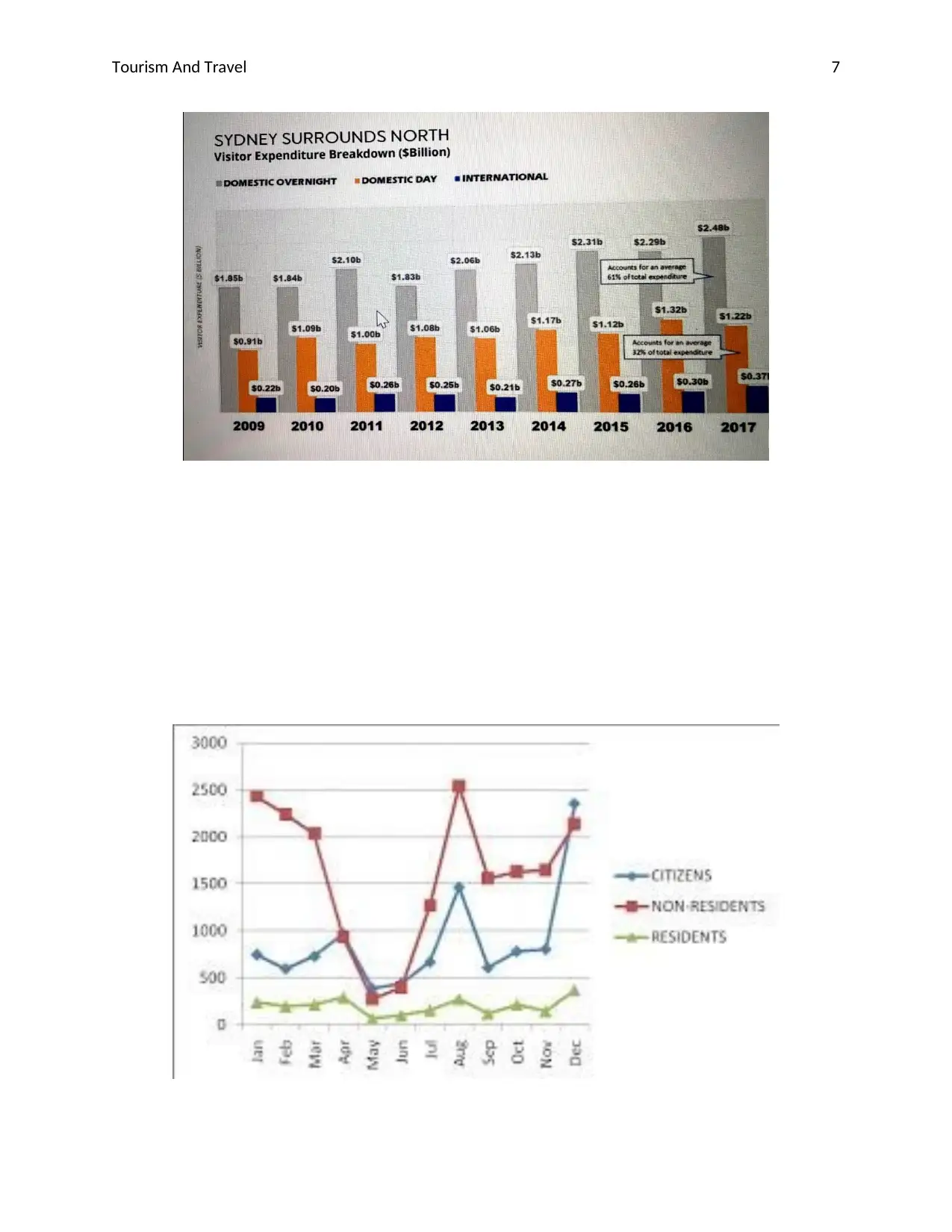
Tourism And Travel 7
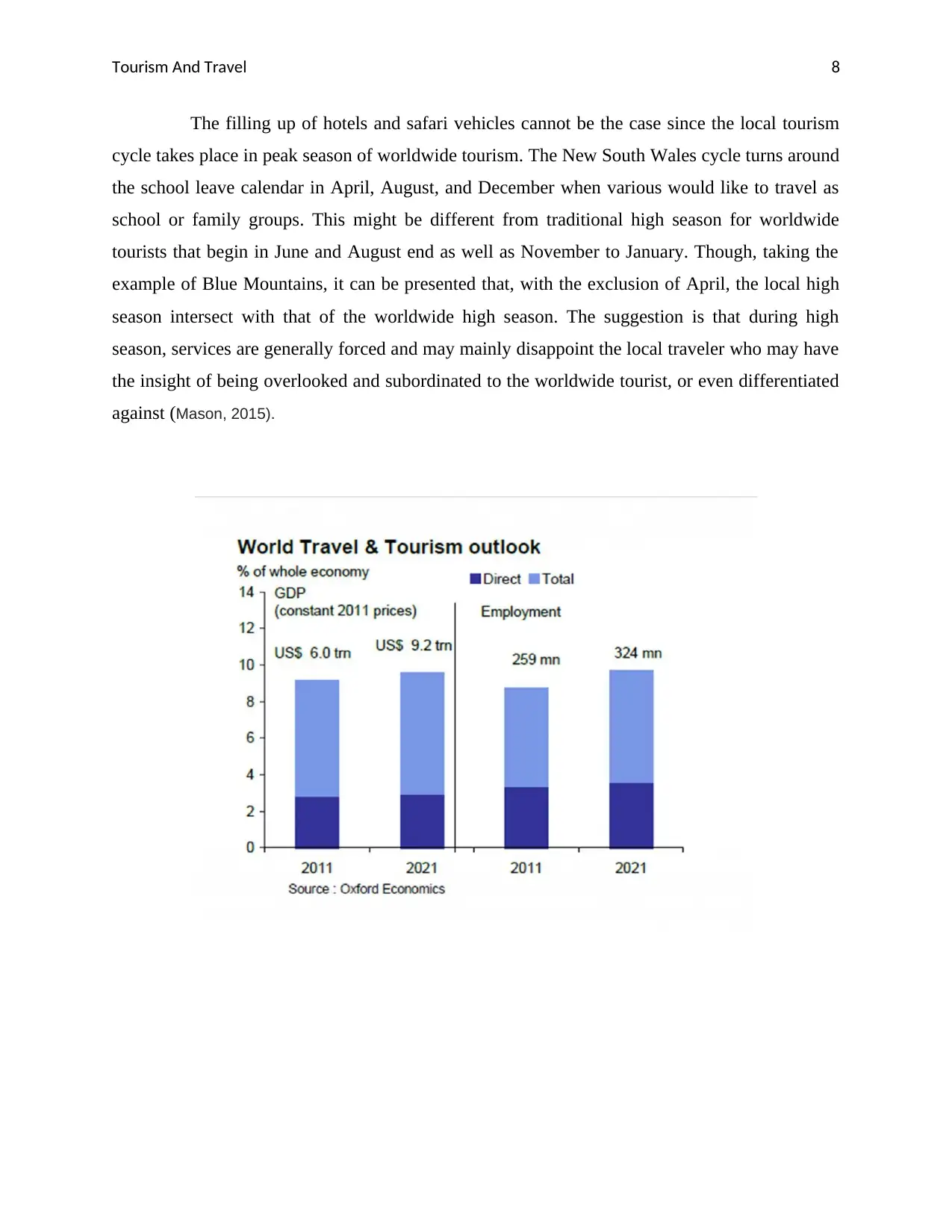
Tourism And Travel 8
The filling up of hotels and safari vehicles cannot be the case since the local tourism
cycle takes place in peak season of worldwide tourism. The New South Wales cycle turns around
the school leave calendar in April, August, and December when various would like to travel as
school or family groups. This might be different from traditional high season for worldwide
tourists that begin in June and August end as well as November to January. Though, taking the
example of Blue Mountains, it can be presented that, with the exclusion of April, the local high
season intersect with that of the worldwide high season. The suggestion is that during high
season, services are generally forced and may mainly disappoint the local traveler who may have
the insight of being overlooked and subordinated to the worldwide tourist, or even differentiated
against (Mason, 2015).
The filling up of hotels and safari vehicles cannot be the case since the local tourism
cycle takes place in peak season of worldwide tourism. The New South Wales cycle turns around
the school leave calendar in April, August, and December when various would like to travel as
school or family groups. This might be different from traditional high season for worldwide
tourists that begin in June and August end as well as November to January. Though, taking the
example of Blue Mountains, it can be presented that, with the exclusion of April, the local high
season intersect with that of the worldwide high season. The suggestion is that during high
season, services are generally forced and may mainly disappoint the local traveler who may have
the insight of being overlooked and subordinated to the worldwide tourist, or even differentiated
against (Mason, 2015).
⊘ This is a preview!⊘
Do you want full access?
Subscribe today to unlock all pages.

Trusted by 1+ million students worldwide
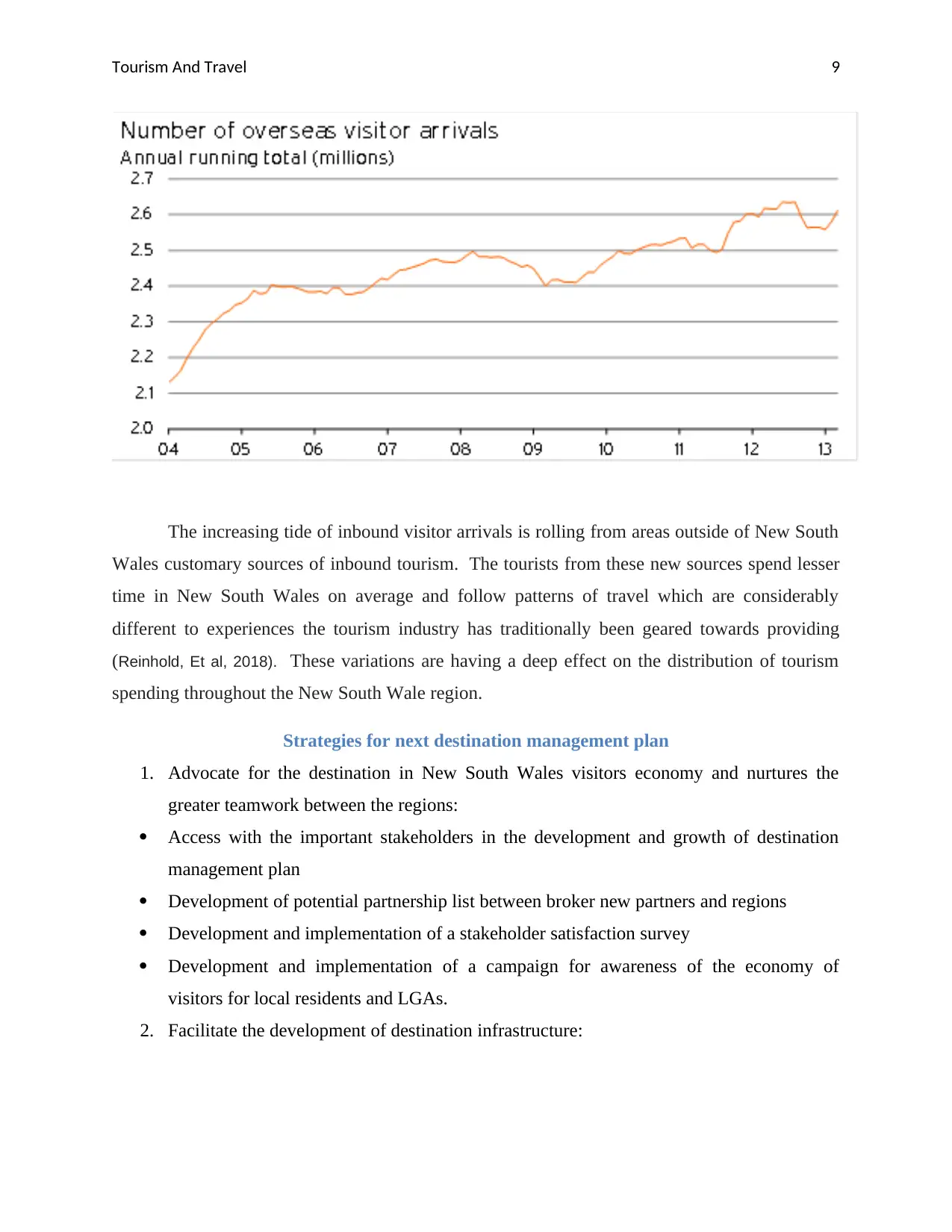
Tourism And Travel 9
The increasing tide of inbound visitor arrivals is rolling from areas outside of New South
Wales customary sources of inbound tourism. The tourists from these new sources spend lesser
time in New South Wales on average and follow patterns of travel which are considerably
different to experiences the tourism industry has traditionally been geared towards providing
(Reinhold, Et al, 2018). These variations are having a deep effect on the distribution of tourism
spending throughout the New South Wale region.
Strategies for next destination management plan
1. Advocate for the destination in New South Wales visitors economy and nurtures the
greater teamwork between the regions:
Access with the important stakeholders in the development and growth of destination
management plan
Development of potential partnership list between broker new partners and regions
Development and implementation of a stakeholder satisfaction survey
Development and implementation of a campaign for awareness of the economy of
visitors for local residents and LGAs.
2. Facilitate the development of destination infrastructure:
The increasing tide of inbound visitor arrivals is rolling from areas outside of New South
Wales customary sources of inbound tourism. The tourists from these new sources spend lesser
time in New South Wales on average and follow patterns of travel which are considerably
different to experiences the tourism industry has traditionally been geared towards providing
(Reinhold, Et al, 2018). These variations are having a deep effect on the distribution of tourism
spending throughout the New South Wale region.
Strategies for next destination management plan
1. Advocate for the destination in New South Wales visitors economy and nurtures the
greater teamwork between the regions:
Access with the important stakeholders in the development and growth of destination
management plan
Development of potential partnership list between broker new partners and regions
Development and implementation of a stakeholder satisfaction survey
Development and implementation of a campaign for awareness of the economy of
visitors for local residents and LGAs.
2. Facilitate the development of destination infrastructure:
Paraphrase This Document
Need a fresh take? Get an instant paraphrase of this document with our AI Paraphraser
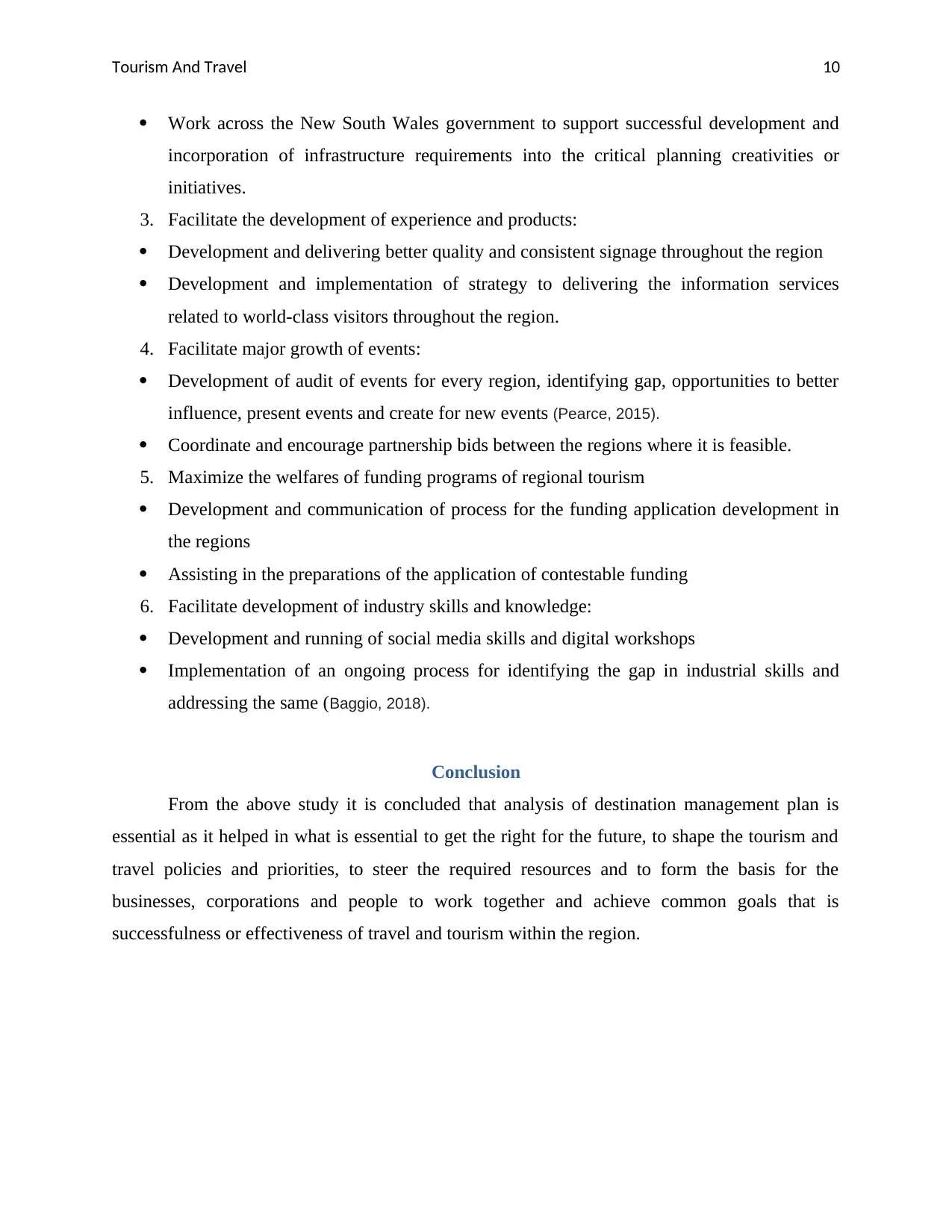
Tourism And Travel 10
Work across the New South Wales government to support successful development and
incorporation of infrastructure requirements into the critical planning creativities or
initiatives.
3. Facilitate the development of experience and products:
Development and delivering better quality and consistent signage throughout the region
Development and implementation of strategy to delivering the information services
related to world-class visitors throughout the region.
4. Facilitate major growth of events:
Development of audit of events for every region, identifying gap, opportunities to better
influence, present events and create for new events (Pearce, 2015).
Coordinate and encourage partnership bids between the regions where it is feasible.
5. Maximize the welfares of funding programs of regional tourism
Development and communication of process for the funding application development in
the regions
Assisting in the preparations of the application of contestable funding
6. Facilitate development of industry skills and knowledge:
Development and running of social media skills and digital workshops
Implementation of an ongoing process for identifying the gap in industrial skills and
addressing the same (Baggio, 2018).
Conclusion
From the above study it is concluded that analysis of destination management plan is
essential as it helped in what is essential to get the right for the future, to shape the tourism and
travel policies and priorities, to steer the required resources and to form the basis for the
businesses, corporations and people to work together and achieve common goals that is
successfulness or effectiveness of travel and tourism within the region.
Work across the New South Wales government to support successful development and
incorporation of infrastructure requirements into the critical planning creativities or
initiatives.
3. Facilitate the development of experience and products:
Development and delivering better quality and consistent signage throughout the region
Development and implementation of strategy to delivering the information services
related to world-class visitors throughout the region.
4. Facilitate major growth of events:
Development of audit of events for every region, identifying gap, opportunities to better
influence, present events and create for new events (Pearce, 2015).
Coordinate and encourage partnership bids between the regions where it is feasible.
5. Maximize the welfares of funding programs of regional tourism
Development and communication of process for the funding application development in
the regions
Assisting in the preparations of the application of contestable funding
6. Facilitate development of industry skills and knowledge:
Development and running of social media skills and digital workshops
Implementation of an ongoing process for identifying the gap in industrial skills and
addressing the same (Baggio, 2018).
Conclusion
From the above study it is concluded that analysis of destination management plan is
essential as it helped in what is essential to get the right for the future, to shape the tourism and
travel policies and priorities, to steer the required resources and to form the basis for the
businesses, corporations and people to work together and achieve common goals that is
successfulness or effectiveness of travel and tourism within the region.
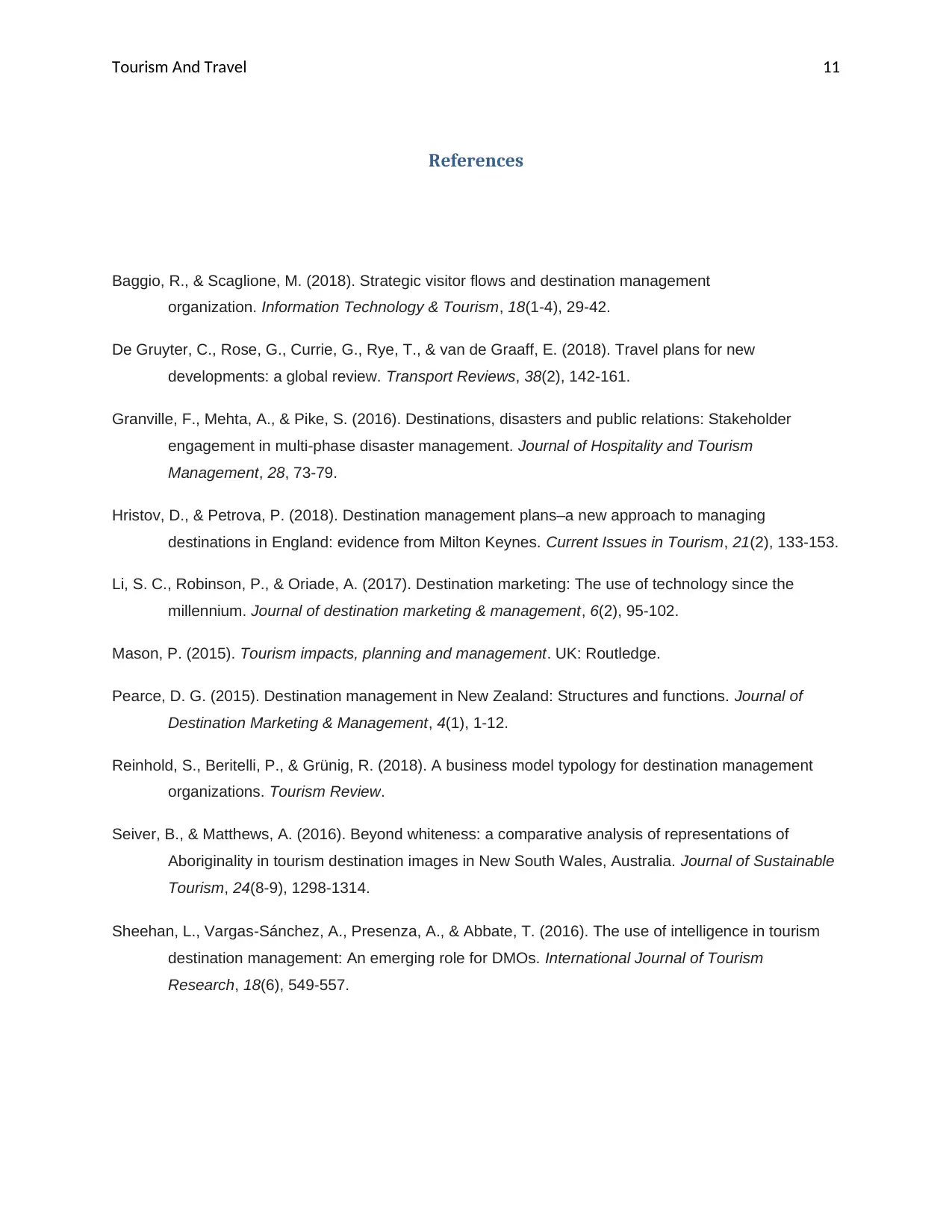
Tourism And Travel 11
References
Baggio, R., & Scaglione, M. (2018). Strategic visitor flows and destination management
organization. Information Technology & Tourism, 18(1-4), 29-42.
De Gruyter, C., Rose, G., Currie, G., Rye, T., & van de Graaff, E. (2018). Travel plans for new
developments: a global review. Transport Reviews, 38(2), 142-161.
Granville, F., Mehta, A., & Pike, S. (2016). Destinations, disasters and public relations: Stakeholder
engagement in multi-phase disaster management. Journal of Hospitality and Tourism
Management, 28, 73-79.
Hristov, D., & Petrova, P. (2018). Destination management plans–a new approach to managing
destinations in England: evidence from Milton Keynes. Current Issues in Tourism, 21(2), 133-153.
Li, S. C., Robinson, P., & Oriade, A. (2017). Destination marketing: The use of technology since the
millennium. Journal of destination marketing & management, 6(2), 95-102.
Mason, P. (2015). Tourism impacts, planning and management. UK: Routledge.
Pearce, D. G. (2015). Destination management in New Zealand: Structures and functions. Journal of
Destination Marketing & Management, 4(1), 1-12.
Reinhold, S., Beritelli, P., & Grünig, R. (2018). A business model typology for destination management
organizations. Tourism Review.
Seiver, B., & Matthews, A. (2016). Beyond whiteness: a comparative analysis of representations of
Aboriginality in tourism destination images in New South Wales, Australia. Journal of Sustainable
Tourism, 24(8-9), 1298-1314.
Sheehan, L., Vargas‐Sánchez, A., Presenza, A., & Abbate, T. (2016). The use of intelligence in tourism
destination management: An emerging role for DMOs. International Journal of Tourism
Research, 18(6), 549-557.
References
Baggio, R., & Scaglione, M. (2018). Strategic visitor flows and destination management
organization. Information Technology & Tourism, 18(1-4), 29-42.
De Gruyter, C., Rose, G., Currie, G., Rye, T., & van de Graaff, E. (2018). Travel plans for new
developments: a global review. Transport Reviews, 38(2), 142-161.
Granville, F., Mehta, A., & Pike, S. (2016). Destinations, disasters and public relations: Stakeholder
engagement in multi-phase disaster management. Journal of Hospitality and Tourism
Management, 28, 73-79.
Hristov, D., & Petrova, P. (2018). Destination management plans–a new approach to managing
destinations in England: evidence from Milton Keynes. Current Issues in Tourism, 21(2), 133-153.
Li, S. C., Robinson, P., & Oriade, A. (2017). Destination marketing: The use of technology since the
millennium. Journal of destination marketing & management, 6(2), 95-102.
Mason, P. (2015). Tourism impacts, planning and management. UK: Routledge.
Pearce, D. G. (2015). Destination management in New Zealand: Structures and functions. Journal of
Destination Marketing & Management, 4(1), 1-12.
Reinhold, S., Beritelli, P., & Grünig, R. (2018). A business model typology for destination management
organizations. Tourism Review.
Seiver, B., & Matthews, A. (2016). Beyond whiteness: a comparative analysis of representations of
Aboriginality in tourism destination images in New South Wales, Australia. Journal of Sustainable
Tourism, 24(8-9), 1298-1314.
Sheehan, L., Vargas‐Sánchez, A., Presenza, A., & Abbate, T. (2016). The use of intelligence in tourism
destination management: An emerging role for DMOs. International Journal of Tourism
Research, 18(6), 549-557.
⊘ This is a preview!⊘
Do you want full access?
Subscribe today to unlock all pages.

Trusted by 1+ million students worldwide
1 out of 12
Related Documents
Your All-in-One AI-Powered Toolkit for Academic Success.
+13062052269
info@desklib.com
Available 24*7 on WhatsApp / Email
![[object Object]](/_next/static/media/star-bottom.7253800d.svg)
Unlock your academic potential
Copyright © 2020–2025 A2Z Services. All Rights Reserved. Developed and managed by ZUCOL.




